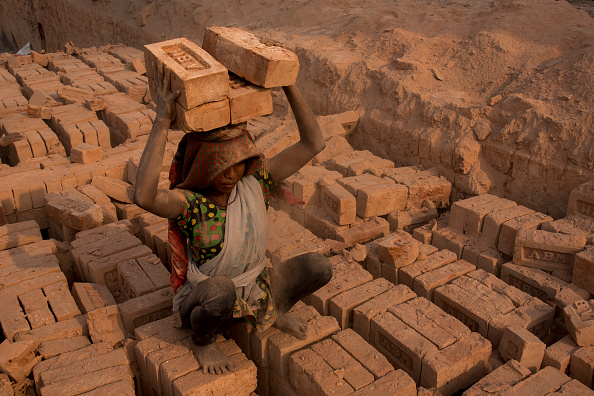The scope of the problem
Human trafficking and modern slavery are crimes that affect marginalized populations. While victims often contribute to the formal economy (in construction, retail, manufacturing, etc.), the coercion and threats that they work under are typically illicit, and these crimes are often classified as being part of the underground economy. Forced labor occurs so often in particular jobs that the International Labour Organization (ILO) has found it helpful to assess problem industries. Astonishingly, Global Estimates of Modern Slavery1 has determined that the construction industry ranks as the second–highest sector after domestic service in terms of risk of forced labor.
The modern anti-trafficking framework combines many different concepts commonly used in legal and non-legal regimes to describe compelled service; concepts that are at times confusing and seemingly contradictory, that flow from different instruments and laws, and are accompanied by structures and constituencies that built up over the 20th century. The “Why you need to assess risk” section of this report sets forth many of the different laws and concepts. But no matter how the different laws are written, we are centering our activism on the situations in which someone’s labor or services are obtained or maintained through some coercive force, whether psychological, physical, or legal.
According to the ILO’s economic analysis, modern slavery is an estimated $150 billion criminal industry worldwide.2 In their jointly undertaken Global Estimate of Modern Slavery, the International Organization for Migration and the Walk Free Foundation assert that almost 28 million people are held in servitude for forced labor and 160 million children from the ages of five to 17 are subjected to child labor.3 In the past five years, 89 million people experienced some form of modern slavery for some period of time, ranging from a few days to the whole five years. According to the estimate, modern slavery occurred in every region of the world.4
Operable Legal Standards and Concepts
While scholars and diplomats can contest the fine nuances among the various terms, this report uses such terms as modern slavery, forced labor, human trafficking, involuntary servitude, and related terms largely interchangeably, reflecting the global policy consensus that compelled service — whether triggered by debt, overt force and threats, psychological manipulation, or document confiscation — is properly criminalized.
That global consensus was brought together as a unified effort in the year 2000 with the passage of the U.S.’ Trafficking Victims Protection Act5 and the United Nations’ Trafficking in Persons protocol,6 and has been sharpened since then through laws at national and sub-national levels, most notably in common-law countries such as the U.S., the U.K., and Australia. Corresponding European laws are broader, reaching a wider set of human rights issues about which companies must undertake due diligence. Regardless of the variations of these instruments, they boil down to one takeaway: firms are no longer able to outsource responsibility for abuses in their supply chain, but now have a duty of care to know who makes their inputs and under what conditions.
The new laws define the heart of the human trafficking concept as the exploitation of a person, and address all of the activities involved in reducing someone to (or holding them in) compelled service, effectively extending liability to everyone from a recruiter in a village to a boss who enslaved a worker. In recent years, this idea of expanded responsibility has extended further, holding accountable those who would profit from trafficking in their supply, those who use trafficking victims in commercial sex, and even governments that turn away from their duties of investigation or victim protection.
Another form of exploitation, which is unfortunately widespread globally and in its worst forms involving forced labor, is that of child labor. Some child labor is considered uncoerced, but is still banned under international practice and domestic law. More dangerous or coercive instances of child labor, and those involving commercial sexual activity, are classified by international law as the “Worst Forms of Child Labor.” These forms of child labor are strictly prohibited, no matter the age of the child, the type of work, or the conditions and circumstances of the work.
Definitions
Modern slavery is defined as “situations of exploitation that persons cannot refuse or leave because of threats, violence, coercion, deception, and/or abuse.”7
Forced labor is defined as “all work or service that is exacted from any person under the menace of any penalty and for which the said person has not offered themselves voluntarily.
A forced labour situation is determined by the nature of the relationship between a person and an ‘employer’ and not by the type of activity performed, however arduous or hazardous the conditions of work may be, nor by its legality or illegality under national law.”8
Child labor is defined as “work performed by a child under coercion applied by a third party either to the child or the child’s parents, or work performed by a child as direct consequence of his or her parents being involved in forced labor.”9
1 Global Estimates of Modern Slavery: Forced Labour and Forced Marriage, International Labour Organization (ILO). Geneva, September 2022.
2 Profits and Poverty: The Economics of Forced Labour, International Labor Organization (ILO). Geneva, 2014.
3 Child Labour Global Estimates 2020, Trends and the Road Forward. UNICEF and the International Labour Organization (ILO). Geneva, 2021.
4 Global Estimates of Modern Slavery: Forced Labour and Forced Marriage, International Labour Organization (ILO). Geneva, September 2022.
5 Victims of Trafficking and Violence Prevention Act (TVPA), Public Law 106-386. October 28, 2000.
6 Protocol to Prevent, Suppress and Punish Trafficking in Persons, Especially Women and Children, United Nations. New York, November 15, 2000.
7 Global Estimates of Modern Slavery: Forced Labour and Forced Marriage, International Labour Organization (ILO). Geneva, September 2022.
8 Ibid.
9 Ibid.

